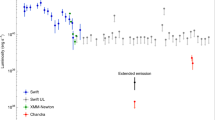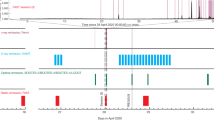Abstract
THE X-ray properties of pulsars (highly magnetized rotating neutron stars) depend mainly on the age of the star1. For young (≤ 104 yr) pulsars, virtually all of the X-ray emission is pulsed, appearing as sharp bursts with a power-law spectrum; these emissions are thought to arise from the acceleration of electrons and positrons in the pulsar's magnetosphere2–5. Older pulsars, on the other hand, exhibit broad X-ray pulses, a lower pulsed fraction and black-body spectra; this is ascribed to thermal emission from the surface of the cooling neutron star, the modulation of the X-rays reflecting temperature inhomogeneities induced by the strong magnetic fields6,7. No thermal emission is expected for neutron stars older than ∼106 yr (refs 8–10) in the absence of surface heating processes11–15. Here we report the discovery of pulsed X-ray emission from a ∼2 × 109-yr-old neutron star: the binary milli-second pulsar J0437 – 4715. The spectral properties of the pulsed emission suggest a thermal origin, requiring substantial heating of the neutron-star surface either by internal friction11–13 or by energetic particles streaming onto the polar cap from the pulsar's magnetosphere14,15.
This is a preview of subscription content, access via your institution
Access options
Subscribe to this journal
Receive 51 print issues and online access
$199.00 per year
only $3.90 per issue
Buy this article
- Purchase on Springer Link
- Instant access to full article PDF
Prices may be subject to local taxes which are calculated during checkout
Similar content being viewed by others
References
Ögelman, H. in Isolated Pulsars (eds Van Riper, K. A., Epstein, R. I. & Ho, C.) 98–102 (Cambridge Univ. Press, 1993).
Goldreich, P. & Julian, W. Astrophys. J. 157, 869–880 (1969).
Cheng, K. S., Ho, C. & Ruderman, M. Astrophys. J. 300, 500–539 (1986).
Chiang, J. & Romani, R. W. Astrophys. J. 400, 629–637 (1992).
Ruderman, M., Chen, K., Cheng, K. S. & Halpern, J. P. Astrophys. J. (submitted); also as Columbia Univ. Astrophys. Lab. preprint No. 510.
Greenstein, G. & Hartke, G. J. Astr. Astrophys. 271, 283–293 (1983).
Ventura, J., Shibanov, Y. A., Zavlin, V. E. & Pavlov, G. G. in Isolated Pulsars (eds Van Riper, K. A., Epstein, R. I. & Ho, C.) 168–173 (Cambridge Univ. Press, 1993).
Page, D. Astrophys. J. (submitted); also as Columbia Univ. Astrophys. Lab. preprint.
Van Riper, K. A. Astrophys. J. Suppl. Ser. 75, 449–462 (1991).
Tsuruta, S. in Isolated Pulsars (eds Van Riper, K. A., Epstein, R. I. & Ho, C.) 129–136 (Cambridge Univ. Press, 1993).
Alpar, M. A., Anderson, P. W., Pines, D. & Saham, J. Astrophys. J. 278, 791–805 (1984).
Shibazaki, N. & Lamb, F. K. Astrophys. J. 346, 808–822 (1989).
Umeda, H., Shibazaki, N., Nomoto, K. & Tsuruta, S. Astrophys. J. 408, 186–193 (1993).
Cheng, A. F. & Ruderman, M. Astrophys. J. 235, 576–586 (1980).
Arons, J. Astrophys. J. 248, 1099–1116 (1981).
Johnston, S. et al. Nature 361, 613–615 (1993).
Becker, W., Trümper, J., Brazier, K. T. S. & Belloni, T., IAU Circ. No. 5701.
Danziger, I. J., Baade, D. & Della Valle, M. Astr. Astrophys. (in the press).
Brailyn, C. D. Astrophys. J. 411, L83–L85 (1993).
Backer, D. C. & Hellings, R. W. A. Rev. Astr. Astrophys. 24, 537–575 (1986).
Blandford, R. & Teukolsky, S. A. Astrophys. J. 205, 580–591 (1976).
Becker, W., Brazier, K. T. S. & Trümper, J. Astr. Astrophys. 273, 421–424 (1993).
Standish, E. M. Astr. Astrophys. 114, 297–302 (1982).
Buccheri, R. & De Jager, O. C. in Timing Neutron Stars (eds Ögelman H. & van den Heuvel, E. P. J.) 95–111 (Kluwer, Dordrecht, 1989).
Ögelman, H. B. (preprint) Adv. in Space Res. Proc. 39th COSPAR Meeting. August September 1992, Washington DC.
Becker, W., Trümper, J. & Ögelman, H. B. in Isolated Pulsars (eds Van Riper, K. A., Epstein, R. I. & Ho, C.) 104–109 (Cambridge Univ. Press, 1993).
Kulkarni, S. R., Phinney, E. S., Evants, C. R. & Hasinger, G. Nature 359, 300–302 (1992).
Fruchter, A. S., Bookbinder, J., Garcia, M. R. & Bailyn, C. D. Nature 359, 303–304 (1992).
Ögelman, H. & Finley, J. P. Astr. Astrophys. 413, L31–L34 (1993).
Halpern, J. P. & Ruderman, M. Astrophys. J. 415, 286–297 (1993). Columbia Univ. Astrophys. Lab. preprint 512.
Author information
Authors and Affiliations
Rights and permissions
About this article
Cite this article
Becker, W., Trümper, J. Detection of pulsed X-rays from the binary millisecond pulsar J0437 – 4715. Nature 365, 528–530 (1993). https://doi.org/10.1038/365528a0
Received:
Accepted:
Issue Date:
DOI: https://doi.org/10.1038/365528a0
This article is cited by
-
Studying millisecond pulsars in X-rays
Astrophysics and Space Science (2007)
Comments
By submitting a comment you agree to abide by our Terms and Community Guidelines. If you find something abusive or that does not comply with our terms or guidelines please flag it as inappropriate.



